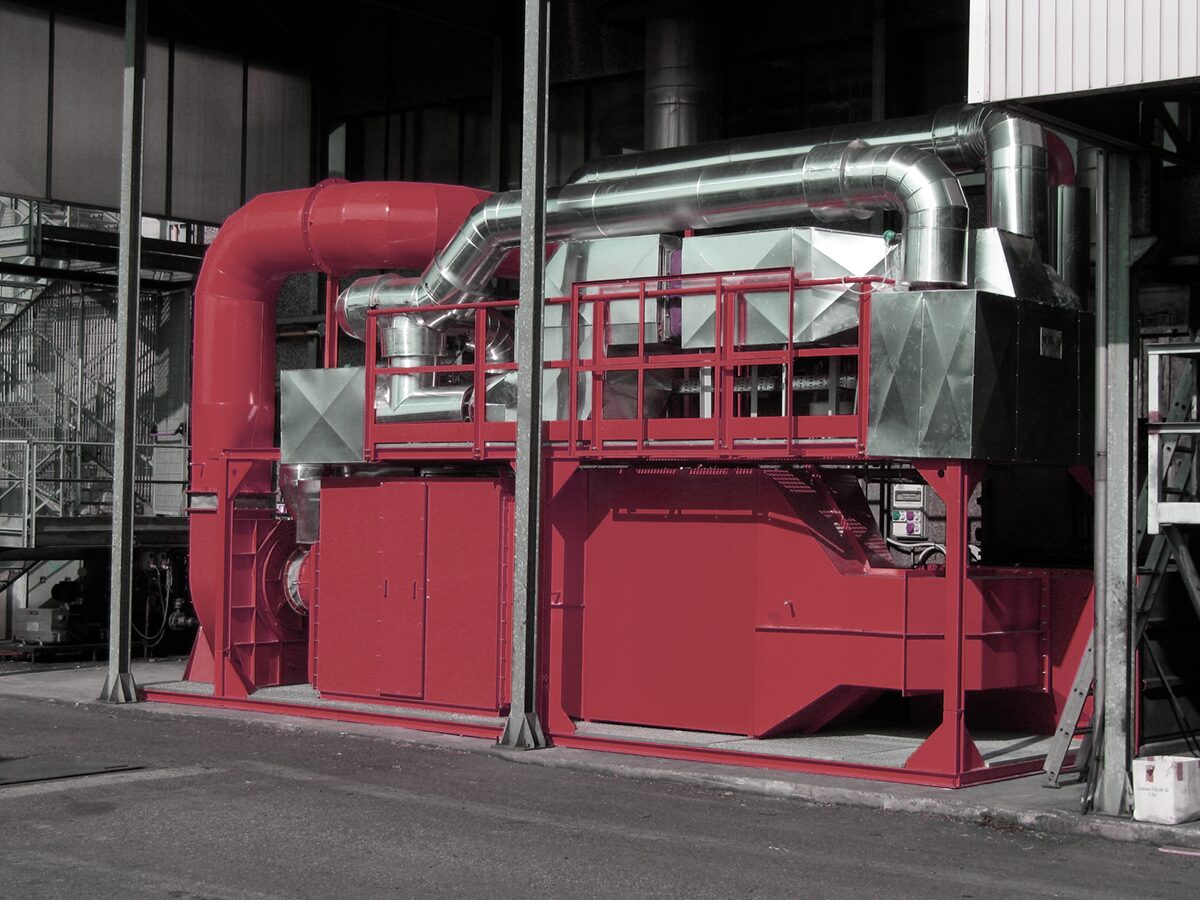The thermal recovery section preheats the air to be treated before entering the combustion chamber, at the same time cooling the outgoing purified air. A further heat recovery can be obtained downstream of the system, by exploiting the residual heat of the purified air to warm different services (air, diathermic oil, water, etc.) and further reduce managing costs.
Recuperative thermal oxidizer features and advantages
- Electrical switchgear with PLC and remote assistance.
- Independent combustion system to guarantee correct operation of the plant.
- Modulating combustion system to maintain the correct operating temperature with different incoming pollutant loads.
- Combustion chamber refractory interior with high density ceramic fibre insulation, allowing the plant to last longer.
- High purification efficiency >99%.
- Thermal efficiency < 65% depending on the different applications.
- Reduced production of secondary pollutants (CO, NOx).
- Possibility of additional heat recovery.
- Easy to manage and use.
Operating principle of recuperative thermal oxidizer
Recuperative thermal oxidizers, compared to direct thermal oxidizers, have a thermal recovery section downstream of the combustion chamber where the outgoing purified fumes preheat the incoming polluted air. Based on the type of plant to be developed, the heat recovery section can be integrated and coaxial to the combustion chamber, or after and independent from it. All solutions are just as efficient, only the process they are applied to changes. These systems make it possible to reach thermal efficiency up to 65%, reducing the output of the installed burner and thereby decreasing the energy demand of the machine. The sensitive heat of the fumes leaving the heat exchanger can be further recovered by installing a second exchanger, supplying additional heat for the customers, for example diathermic oil, water or simply air and to further reduce management costs. These machines are often applied in the chemical, pharmaceutical, painting and waste processing industries and can be equipped with all the pre-and post treatment systems making them useful for the intended purpose.
Plant engineering solutions
- Pretreatment for pollutants containing silicon (silanes, siloxanes…) or streams containing dust.
- Heat exchangers in special alloys for applications with corrosive gases.
- Management system of high concentrations made with modulation and bypass valves to prevent temperature rises.
- Secondary heat recovery thanks to our energy recovery solutions.
- Low emission NOx burners and/or deNOx SCR (Selective Catalytic Reduction) systems.
- Turnkey supply.
Thermal oxidizers with pre/post treatment
Plants designed by integrating pre-and post abatement sections to the main oxidizer are used when complex pollutant streams need to be treated with several different technologies.
The pre-treatments and therefore the pre-scrubbers are used to preserve the thermal oxidizer both from a mechanical and process point of view, reducing the concentration of particular types of pollutants such as:
organic silicone compounds
inorganic acids
inorganic bases
aerosol
dust
painting overspray
oily mist and/or condensate droplets
In this condition, appropriate systems are installed, such as cyclones, bag or cartridge filters, Venturi and tower scrubbers, filtering panels, activated carbon adsorbers, various types of demisters or even more complex systems to evaluate for each case.
For post-treatments and therefore for the post-scrubbers, rapid cooling systems are typically used such as quenchers followed by tower scrubbers possibly with Venturi-pre-abatement.
At times DeNOx SCR or SNCR systems could need to be used to reduce NOx consisting of particular organic compounds such as amines.
The various post-abatement systems are applied in the presence of incoming pollutants such as:
Halogenated VOC
Sulphurised VOC
Nitrogenous VOC
Silanes or siloxanes
Services provided
Choosing Brofind means:
- Customer assistance 24/7
- Impartiality in recommending pollution control technologies since Brofind is owner of many of them
- Experience in the design and manufacturing of abatement plants since 1993
See the page dedicated to Brofind services to understand how we support our customers during the entire lifecycle of the product.





